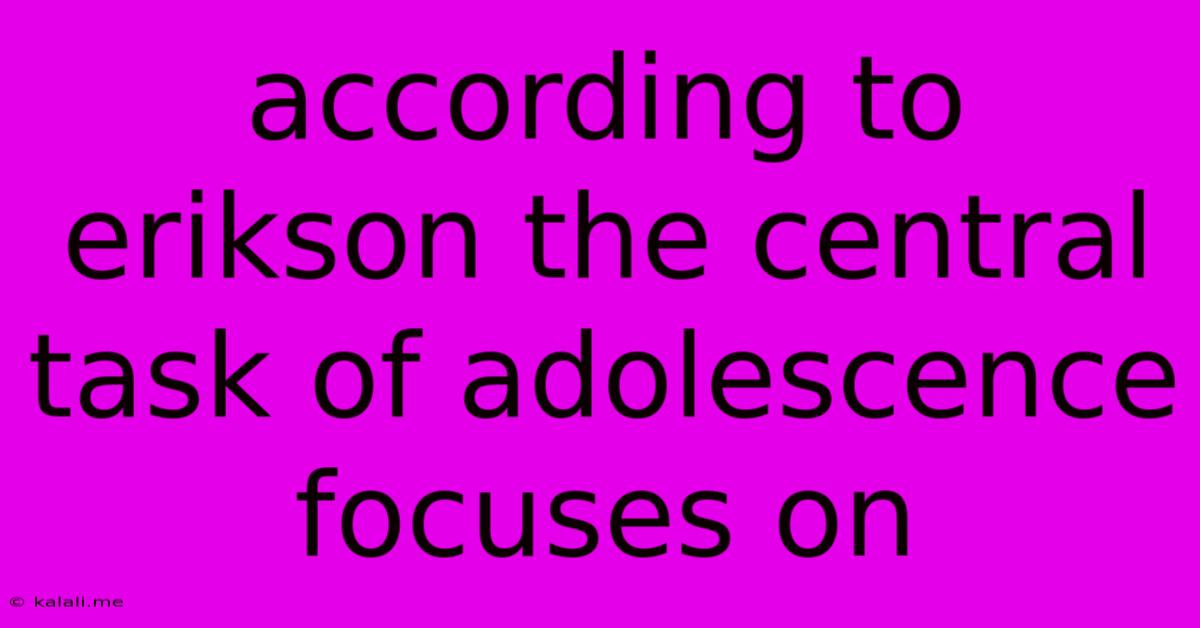According To Erikson The Central Task Of Adolescence Focuses On
Kalali
Jun 13, 2025 · 4 min read

Table of Contents
According to Erikson, the Central Task of Adolescence Focuses on Identity vs. Role Confusion
The teenage years, a period often characterized by dramatic physical, emotional, and social changes, represent a crucial developmental stage according to Erik Erikson's theory of psychosocial development. Erikson posited that the central task of adolescence, spanning roughly from ages 12 to 18, focuses on resolving the identity vs. role confusion crisis. This stage is pivotal because it lays the foundation for future relationships, career choices, and overall sense of self. Failing to navigate this stage successfully can lead to feelings of uncertainty and instability throughout adulthood.
This article will delve deeper into Erikson's theory, exploring the core components of the identity vs. role confusion stage, its potential outcomes, and the factors that influence its successful resolution. We'll examine how this stage impacts the development of a strong sense of self and the challenges faced by adolescents as they grapple with their evolving identity.
Understanding Erikson's Stages of Psychosocial Development
Before focusing specifically on adolescence, it's helpful to understand Erikson's broader theory. He proposed eight distinct stages, each characterized by a specific psychosocial crisis that must be resolved. Successful resolution leads to the development of a specific virtue or strength, while failure can result in feelings of inadequacy and difficulty navigating future stages. Adolescence marks the fifth stage in this sequence. The earlier stages (trust vs. mistrust, autonomy vs. shame and doubt, initiative vs. guilt, and industry vs. inferiority) build the foundation upon which adolescents attempt to integrate their experiences into a cohesive sense of self.
Identity vs. Role Confusion: The Core of Adolescent Development
During the identity vs. role confusion stage, adolescents actively search for answers to fundamental questions about themselves: "Who am I?", "What are my values?", "What are my beliefs?", and "Where do I fit in?". This exploration involves experimenting with different roles, identities, and beliefs. They might try out different styles of clothing, explore various social groups, engage in different activities, and consider various career paths. This experimentation is crucial for self-discovery and the formation of a coherent sense of self.
The Importance of Exploration and Experimentation
Erikson stressed the importance of exploration during this stage. Adolescents need the freedom and support to explore different aspects of their identity without fear of judgment or criticism. This exploration may involve questioning authority, rebelling against parental expectations, or engaging in risky behaviors (although excessive risk-taking is a sign of struggle, not necessarily successful exploration). The process involves developing a strong sense of self that is independent and stable. This includes exploring their values, beliefs, and goals.
Successful navigation of this stage leads to a strong sense of identity, characterized by a clear understanding of one's values, beliefs, and goals. This strong sense of self provides a foundation for future relationships, career choices, and overall well-being.
Role Confusion: The Negative Outcome
Failure to resolve the identity vs. role confusion crisis can lead to role confusion or identity diffusion. Individuals experiencing role confusion feel lost, uncertain about their future, and lack a clear sense of self. They may struggle to form meaningful relationships, make decisions, or commit to long-term goals. This can manifest as feelings of apathy, alienation, and a lack of direction in life. Furthermore, it can also impact their self-esteem and confidence. This feeling of uncertainty can lead to further difficulties in adulthood.
Several factors can contribute to role confusion, including parental pressure, societal expectations, peer influence, and significant life events (such as trauma or loss).
Factors influencing successful resolution:
Several factors contribute to a successful resolution of the identity vs. role confusion stage:
- Supportive environment: A supportive family and social environment is crucial for allowing adolescents to explore their identity without fear of judgment or rejection.
- Positive role models: Having positive role models can help adolescents identify with certain values and beliefs, providing them with a framework for their own identity.
- Opportunities for exploration: Access to various experiences and opportunities allows adolescents to experiment with different roles and identities.
- Self-reflection: The ability to reflect on one's experiences and make meaning of them is crucial for integrating different aspects of the self into a coherent whole.
In conclusion, Erikson's theory highlights the critical role of the identity vs. role confusion stage in adolescent development. Successful navigation of this stage, fostered by a supportive environment and opportunities for exploration, is crucial for developing a strong sense of self and laying the groundwork for a fulfilling adult life. Understanding this process enables parents, educators, and mentors to support adolescents in their journey towards self-discovery and personal growth.
Latest Posts
Latest Posts
-
During Which Phase Of Meiosis Crossing Over Occurs
Jun 14, 2025
-
What Is The Gram Formula Mass Of K2co3
Jun 14, 2025
-
Which Of The Following Is Abiotic
Jun 14, 2025
-
Select All The True Statements About Temperate Coniferous Forests
Jun 14, 2025
-
Rest Mass Energy Of A Proton
Jun 14, 2025
Related Post
Thank you for visiting our website which covers about According To Erikson The Central Task Of Adolescence Focuses On . We hope the information provided has been useful to you. Feel free to contact us if you have any questions or need further assistance. See you next time and don't miss to bookmark.